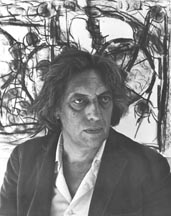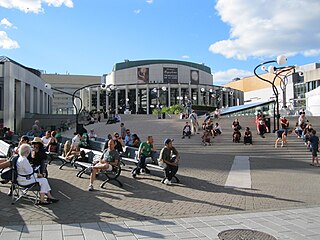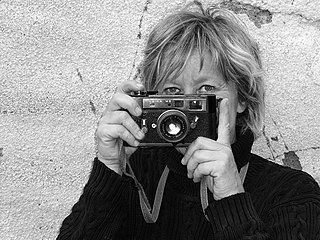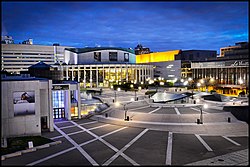
Jean-Paul Riopelle, was a Canadian painter and sculptor from Quebec. He had one of the longest and most important international careers of the sixteen signatories of the Refus Global, the 1948 manifesto that announced the Quebecois artistic community's refusal of clericalism and provincialism. He is best known for his abstract painting style, in particular his "mosaic" works of the 1950s when he famously abandoned the paintbrush, using only a palette knife to apply paint to canvas, giving his works a distinctive sculptural quality. He became the first Canadian painter since James Wilson Morrice to attain widespread international recognition and high praise, both during his career and after his death. He was a leading artist of French Lyrical Abstraction.

Place-des-Arts station is a Montreal Metro station in the borough of Ville-Marie, Montreal, Quebec, Canada. It is operated by the Société de transport de Montréal (STM) and serves the Green Line. The station opened on October 14, 1966, as part of the original network of the Metro. It is located in the Quartier des spectacles district, in east-central downtown.

Joseph Louis Wilfrid Pelletier, was a Canadian conductor, pianist, composer, and arts administrator. He was instrumental in establishing the Montreal Symphony Orchestra, serving as the orchestra's first artistic director and conductor from 1935 to 1941. He had a long and fruitful partnership with the Metropolitan Opera in New York City that began with his appointment as a rehearsal accompanist in 1917; ultimately working there as one of the company's conductors in mainly the French opera repertoire from 1929 to 1950. From 1951 to 1966, he was the principal conductor of the Orchestre Symphonique de Québec. He was also a featured conductor for a number of RCA Victor recordings, including an acclaimed reading of Gabriel Fauré's Requiem featuring baritone Mack Harrell and the Montreal Symphony Orchestra and chorus.

Ville-Marie is the name of a borough (arrondissement) in the centre of Montreal, Quebec. The borough is named after Fort Ville-Marie, the French settlement that would later become Montreal, which was located within the present-day borough. Old Montreal is a National Historic Site of Canada.

Sainte-Catherine Street is the primary commercial artery of Downtown Montreal, Quebec, Canada. It crosses the central business district from west to east, beginning at the corner of Claremont Avenue and de Maisonneuve Boulevard in Westmount, and ending at the Grace Dart Extended Care Centre by Assomption metro station, where it folds back into Notre-Dame Street. It also traverses Ville-Marie, passing just east of Viau in Mercier–Hochelaga-Maisonneuve. The street is 11.2 km long, and considered the backbone of Downtown Montreal.
Claude Tousignant is a Canadian artist. Tousignant is considered to be an important contributor to the development of geometric abstraction in Canada. He masterly used alternating values of complementary colours in innovative ways in his circle/target paintings.

Downtown Montreal is the central business district of Montreal, Quebec, Canada.

Salle Wilfrid-Pelletier is a large multipurpose venue in Montreal, Quebec equipped with sophisticated technical equipment. It seats 2,996 people and is part of the Place des Arts cultural complex in Montréal's Quartier des Spectacles entertainment district. It is the largest multipurpose stage in Canada.
Montreal was referred to as "Canada's Cultural Capital" by Monocle Magazine. The city is Canada's centre for French-language television productions, radio, theatre, film, multimedia, and print publishing. The Quartier Latin is a neighbourhood crowded with cafés animated by this literary and musical activity. Montreal's many cultural communities have given it a distinct local culture.

The Musée d'art contemporain de Montréal is a contemporary art museum in Montreal, Quebec, Canada. It is located on the Place des festivals in the Quartier des spectacles and is part of the Place des Arts complex.

Quartier des Spectacles is an arts and entertainment district located in the eastern section of Downtown Montreal, designed as a centre for Montreal's cultural events and festivals.
Fernand Toupin was a Québécois abstract painter best known as a first-generation member of the avant-garde movement known as Les Plasticiens. Like other members of the group, his shaped paintings drew upon the tradition of geometric abstraction, and he cited Mondrian as a forerunner. In 1959, Toupin began working with a more lyrical, though abstract, way of painting. The last decade of his career saw his return to geometric abstraction. Like Jean-Paul Mousseau, Toupin created works which lay outside the standard boundaries of art such as his stage sets for ballets.
The Conservatoire de musique et d'art dramatique du Québec is a public network of nine state-subsidised schools offering higher education in music and theatre in Quebec, Canada. The organization was established in 1942 as a branch of the Ministère des Affaires culturelles du Québec by the government of Quebec during the premiership of Maurice Duplessis. Orchestra conductor Wilfrid Pelletier and composer Claude Champagne are credited for their zeal in promoting this project, and the two men led the organization as director and assistant director for its first several years. The organization's current director general is Nathalie Letendre.
The Conservatoire de musique du Québec à Québec is a music conservatory located in Quebec City, Quebec, Canada. Founded by the Quebec government in 1944, it became the second North American music institution of higher learning to be entirely state-subsidized. The conservatoire is part of a network of 7 conservatories in Quebec, the Conservatoire de musique et d'art dramatique du Québec (CMADQ), and was the second school in the CMADQ network to be established. Orchestra conductor Wilfrid Pelletier served as the school's first director from 1944 through 1946. The current director is Jean-Fabien Schneider.
Claude Bettinger was a sculptor and stained glass artist. Born in Lyon in 1942, he died in Quebec in 1998.

The Montreal Symphony House is a concert hall in Montreal, Quebec, Canada. The Montreal Symphony House is located at the corner of de Maisonneuve Boulevard West and Saint Urbain Street, on the northeastern esplanade of Place des Arts in the Quartier des Spectacles.

Théâtre Maisonneuve is a theatre in Montreal, Quebec, Canada. It is located at Place des Arts in the Quartier des spectacles neighbourhood in the borough of Ville-Marie.

Claire Beaugrand-Champagne is a Canadian documentary photographer. She is known for her socially engaged work and, having started her career in 1970, is considered the first female press photographer in Quebec. She was a member of the Groupe d'action photographique (GAP) alongside Michel Campeau, Gabor Szilasi, Roger Charbonneau et Pierre Gaudard

Denis Marleau is a Canadian director living in Quebec.
Cooke-Sasseville is a contemporary artistic duo created in Québec City in 2000 by Jean-François Cooke and Pierre Sasseville. Their main mediums are sculpture and installations.























